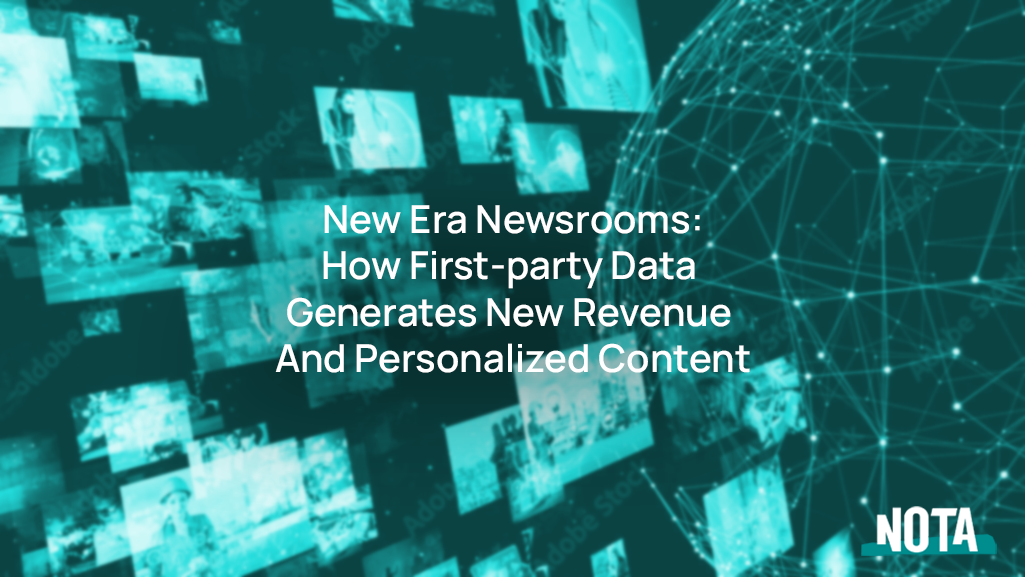In recent years, newsrooms have faced unprecedented challenges due to declining readership and changing media consumption habits, resulting in a significant decline in subscription and advertising sales.
Illustrating this point, a recent analysis of PwC data by the World Association of News Publishers (WAN-IFRA), found that global newspaper print and digital advertising spend decreased from $45.7B in 2019 to $33.3B in 2024.
As audiences continue to evolve online, competition for attention has intensified, forcing many news organizations out of business and leaving those that remain scrambling to identify new sources of revenue. By leveraging both current and historical first-party data, news organizations can unlock new content and revenue strategies. Here’s a look at how legacy information leads to new successes.
Legacy Data is a Goldmine
Legacy data in newsrooms refers to the vast amounts of historical information and content accumulated over the years. This could include past articles, images, videos, audio recordings, research notes and metadata such as publication dates, author information and user engagement metrics. Essentially, it encompasses all the archival content that a news organization produced and stored, often spanning decades.
Think about it – being able to access actionable insights from past content is the holy grail in terms of meeting audience’s needs, or helping hold their attention. But, all too often news organizations have their data assets spread across different departments and tools. Another challenge is presented based on how the company might be structured, and what legacy systems are in place that aren’t compatible with newer technology or solutions. The first step to actualizing new revenue streams and better personalization is breaking down data silos.
Eliminating Data Silos for New Approaches
Data silos within news organizations significantly hinder operational efficiency and actually stunt strategic decision-making. When data is isolated in various departments or systems, it creates barriers to comprehensive analysis and collaboration. This fragmentation means that valuable insights from audience analytics, content performance and advertising revenue are not shared or easily accessible across the organization, leading to missed opportunities.
Additionally, data silos also slow down workflows, as journalists, editors and broader teams struggle to access information promptly, delaying content production and publication. In fact, a recent report from XLPM found that 76 percent of respondents admit data silos hinder cross-departmental exchange.
With this in mind, news and media companies should make a concerted effort to pull together all their data assets – however, it can be difficult to know where to start.
How Nota Makes It Possible
Nota’s AI-powered tools are designed to integrate seamlessly with your existing systems, making all data — both current and historical — immediately accessible and actionable. Here’s a few ways Nota can revolutionize your newsroom:
- Content Optimization – Our AI tools analyze data in real-time, providing insights that help tailor and optimize content for maximum engagement. This includes generating SEO-friendly headlines, meta tags and summaries, integrated directly within the current workflow of your newsroom.
- Operational Efficiency – Many outlets are leaner than in the past; our tools enable journalists to do what they do best – focus on the story and reporting. Our tools like Social and Sum remove the complexity and time-consuming process of developing social media content, compelling headlines, meta tags, trending keywords and more.
- Revenue Generation – Nota facilitates the transformation of data into valuable, marketable content. This includes using data to boost content recirculation and engagement, which in turn can support new revenue streams through subscriptions, direct sales and branded content partnerships.
We’ve seen tremendous results with our clients. For example, Rough Draft Atlanta experienced a 42% reduction in time spent on SEO per article, accompanied by a 13% increase in Instagram posting frequency. This highlights how effective data utilization not only improves efficiency but also opens new avenues for audience engagement and revenue.
A Fresh Wave of Personalization
By unifying first-party data, news organizations can better analyze past performance metrics, and make informed decisions about how to position stories, predict what types of content will resonate with their audience and identify topics that are more or less likely to succeed. Legacy data can also inform long-term editorial strategies by revealing the evolution of audience interests. Together, these insights can effectively boost content development and recirculation, providing more targeted and personalized storytelling, and helping present the right content to the right audience members.
New Revenues in Data Marketplaces
Outside of higher engagement via personalization, an aggregate pool of legacy data could actually be a goldmine for many publications. We’re seeing several data marketplaces emerge, such as Dappier, Human Native, ScalePost AI, TollBit and ProRata. These platforms allow for trading and accessing diverse datasets. According to IoT Analytics, AI is projected to drive significant growth in the data management market, which is expected to reach $513.3 billion by 2030. It’s clear data marketplaces are necessary to actually access the next frontier of innovation in the technology sector – and news organizations have an opportunity to lay the foundation.
If you’d like to find out more about how data marketplaces are becoming pivotal for AI advancements, check out our previous blog post, ‘There’s Gold in Your Media Archives.’
Through comprehensive data integration, real-time analytics and content optimization, newsrooms can enhance efficiency, personalize storytelling, and engage audiences better than ever. This not only revitalizes content creation and distribution, but opens up new revenue streams from subscriptions and direct sales, to branded content and partnerships. Additionally, the emergence of data marketplaces presents an exciting opportunity to monetize aggregated data assets, providing an additional strategy for boosting the bottom line.




